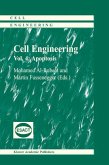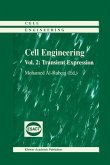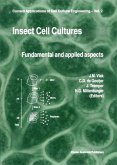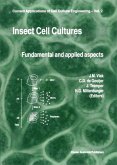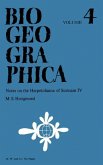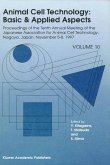Cell Culture Engineering IV
Improvements of Human Health
Herausgegeben:Buckland, B. C.
Cell Culture Engineering IV
Improvements of Human Health
Herausgegeben:Buckland, B. C.
- Broschiertes Buch
- Merkliste
- Auf die Merkliste
- Bewerten Bewerten
- Teilen
- Produkt teilen
- Produkterinnerung
- Produkterinnerung
Cell Culture Engineering IV, Improvements of Human Health covers the latest approaches to improving the cell host through improved understanding of the molecular biology, the development of novel vaccines, approaches to bioreactor design and operation, monitoring techniques in process control and quality related topics. The work was carefully put together as one result of the Cell Culture Engineering IV Meeting held in San Diego, U.S.A. in 1994, however, the book may not be perceived as a proceedings volume - the criteria of the book series apply. For cell biologists, biochemists, molecular…mehr
Andere Kunden interessierten sich auch für
![Cell Culture Engineering IV Cell Culture Engineering IV]() Barry C BucklandCell Culture Engineering IV192,99 €
Barry C BucklandCell Culture Engineering IV192,99 €![Cell Engineering Cell Engineering]() Cell Engineering116,99 €
Cell Engineering116,99 €![Cell Engineering Cell Engineering]() Al-RubeaiCell Engineering83,99 €
Al-RubeaiCell Engineering83,99 €![Insect Cell Cultures Insect Cell Cultures]() Just M. Vlak / Cornelis D. de Gooijer / Johannes Tramper / Herbert G. Miltenburger (eds.)Insect Cell Cultures242,99 €
Just M. Vlak / Cornelis D. de Gooijer / Johannes Tramper / Herbert G. Miltenburger (eds.)Insect Cell Cultures242,99 €![Insect Cell Cultures Insect Cell Cultures]() Insect Cell Cultures242,99 €
Insect Cell Cultures242,99 €![Notes on the herpetofauna of Surinam IV Notes on the herpetofauna of Surinam IV]() M. S. HoogmoedNotes on the herpetofauna of Surinam IV161,99 €
M. S. HoogmoedNotes on the herpetofauna of Surinam IV161,99 €![Animal Cell Technology: Basic & Applied Aspects Animal Cell Technology: Basic & Applied Aspects]() KitagawaAnimal Cell Technology: Basic & Applied Aspects166,99 €
KitagawaAnimal Cell Technology: Basic & Applied Aspects166,99 €-
-
-
Cell Culture Engineering IV, Improvements of Human Health covers the latest approaches to improving the cell host through improved understanding of the molecular biology, the development of novel vaccines, approaches to bioreactor design and operation, monitoring techniques in process control and quality related topics. The work was carefully put together as one result of the Cell Culture Engineering IV Meeting held in San Diego, U.S.A. in 1994, however, the book may not be perceived as a proceedings volume - the criteria of the book series apply.
For cell biologists, biochemists, molecular biologists, immunologists and other disciplines related to cell culture engineering, working in the academic environment, as well as in (biotechnology or pharmaceutical) industry.
For cell biologists, biochemists, molecular biologists, immunologists and other disciplines related to cell culture engineering, working in the academic environment, as well as in (biotechnology or pharmaceutical) industry.
Produktdetails
- Produktdetails
- Current Applications of Cell Culture Engineering 1
- Verlag: Springer / Springer Netherlands
- Artikelnr. des Verlages: 978-94-010-4114-0
- Softcover reprint of the original 1st ed. 1995
- Seitenzahl: 384
- Erscheinungstermin: 13. November 2012
- Englisch
- Abmessung: 260mm x 195mm x 21mm
- Gewicht: 808g
- ISBN-13: 9789401041140
- ISBN-10: 9401041148
- Artikelnr.: 37476988
- Herstellerkennzeichnung
- Books on Demand GmbH
- In de Tarpen 42
- 22848 Norderstedt
- info@bod.de
- 040 53433511
- Current Applications of Cell Culture Engineering 1
- Verlag: Springer / Springer Netherlands
- Artikelnr. des Verlages: 978-94-010-4114-0
- Softcover reprint of the original 1st ed. 1995
- Seitenzahl: 384
- Erscheinungstermin: 13. November 2012
- Englisch
- Abmessung: 260mm x 195mm x 21mm
- Gewicht: 808g
- ISBN-13: 9789401041140
- ISBN-10: 9401041148
- Artikelnr.: 37476988
- Herstellerkennzeichnung
- Books on Demand GmbH
- In de Tarpen 42
- 22848 Norderstedt
- info@bod.de
- 040 53433511
Introduction: Applications of Cell Culture for the improvement of human health.- Cultural and physiological factors affecting expression of recombinant proteins.- Selecting and designing cell lines for improved physiological characteristics.- Applications of improved stoichiometric model in medium design and fed-batch cultivation of animal cells in bioreactor.- Diverse effects of essential (n-6 and n-3) fatty acids on cultured cells.- Enhancement effects of BSA and linoleic acid on hybridoma cell growth and antibody production.- Growth rate suppression of cultured mammalian cells enhances protein productivity.- Growth and interferon-? production in batch culture of CHO cells.- Metabolic and kinetic studies of hybridomas in exponentially fed-batch cultures using T-flasks.- Adaptation of mammalian cells to non-ammoniagenic media.- Effect of endogenous proteins on growth and antibody productivity in hybridoma batch cultures.- Extracellular insulin degrading activity creates instability in a CHO-based batch-refeed continuous process.- Low temperature cultivation - A step towards process optimisation.- Induction of apoptosis in oxygen-deprived cultures of hybridoma cells.- Maximization of recombinant protein yield in the insect cell/baculovirus system by one-time addition of nutrients to high-density batch cultures.- Recombinant protein expression in a Drosophila cell line: comparison with the baculovirus system.- Scale-up of the adenovirus expression system for the production of recombinant protein in human 293S cells.- Relationship between oxygen uptake rate and time of infection of Sf9 insect cells infected with a recombinant baculovirus.- Optimization of vaccine production for animal health.- Evaluation of monitoring approaches and effects of culture conditions onrecombinant protein production in baculovirus-infected insect cells.- The analysis of protein pharmaceuticals: Near future advances.- The effect of protein synthesis inhibitors on the glycosylation site occupancy of recombinant human prolactin.- Effect of lipid supplements on the production and glycosylation of recombinant interferon-? expressed in CHO cells.- Role of environmental conditions on the expression levels, glycoform pattern and levels of sialytransferase for hFSH produced by recombinant CHO cells.- Glycosylation and functional activity of anti-D secreted by two human lymphoblastoid cell lines.- Interaction of cell culture with downstream purification: a case study.- Evaluation of membranes for use in on-line cell separation during mammalian cell perfusion processes.- Vortex flow filtration of mammalian and insect cells.- Automated immunoanalysis systems for monitoring mammalian cell cultivation processes.- A direct computer control concept for mammalian cell fermentation processes.- Automated monitoring of cell concentration and viability using an image analysis system.- Software sensors for the monitoring of perfusion cultures: Evaluation of the hybridoma density and the medium composition from glucose concentration measurements.- Design of a bubble-swarm bioreactor for animal cell culture.- Cells and bubbles in sparged bioreactors.- Quantitative investigations of cell-bubble interactions using a foam fractionation technique.- Prediction of mechanical damage to animal cells in turbulence.- Repeated-batch cultures of Baby Hamster Kidney cell aggregates in stirred vessels.- Towards the development of a bioartificial pancreas: immunoisolation and NMR monitoring of mouse insulinomas.- Overview of a quality assurance / quality control compliance programconsistent with FDA regulations and policies for somatic cell and gene therapies: a four year experience.- Author index.- Keyword index.
Introduction: Applications of Cell Culture for the improvement of human health.- Cultural and physiological factors affecting expression of recombinant proteins.- Selecting and designing cell lines for improved physiological characteristics.- Applications of improved stoichiometric model in medium design and fed-batch cultivation of animal cells in bioreactor.- Diverse effects of essential (n-6 and n-3) fatty acids on cultured cells.- Enhancement effects of BSA and linoleic acid on hybridoma cell growth and antibody production.- Growth rate suppression of cultured mammalian cells enhances protein productivity.- Growth and interferon-? production in batch culture of CHO cells.- Metabolic and kinetic studies of hybridomas in exponentially fed-batch cultures using T-flasks.- Adaptation of mammalian cells to non-ammoniagenic media.- Effect of endogenous proteins on growth and antibody productivity in hybridoma batch cultures.- Extracellular insulin degrading activity creates instability in a CHO-based batch-refeed continuous process.- Low temperature cultivation - A step towards process optimisation.- Induction of apoptosis in oxygen-deprived cultures of hybridoma cells.- Maximization of recombinant protein yield in the insect cell/baculovirus system by one-time addition of nutrients to high-density batch cultures.- Recombinant protein expression in a Drosophila cell line: comparison with the baculovirus system.- Scale-up of the adenovirus expression system for the production of recombinant protein in human 293S cells.- Relationship between oxygen uptake rate and time of infection of Sf9 insect cells infected with a recombinant baculovirus.- Optimization of vaccine production for animal health.- Evaluation of monitoring approaches and effects of culture conditions onrecombinant protein production in baculovirus-infected insect cells.- The analysis of protein pharmaceuticals: Near future advances.- The effect of protein synthesis inhibitors on the glycosylation site occupancy of recombinant human prolactin.- Effect of lipid supplements on the production and glycosylation of recombinant interferon-? expressed in CHO cells.- Role of environmental conditions on the expression levels, glycoform pattern and levels of sialytransferase for hFSH produced by recombinant CHO cells.- Glycosylation and functional activity of anti-D secreted by two human lymphoblastoid cell lines.- Interaction of cell culture with downstream purification: a case study.- Evaluation of membranes for use in on-line cell separation during mammalian cell perfusion processes.- Vortex flow filtration of mammalian and insect cells.- Automated immunoanalysis systems for monitoring mammalian cell cultivation processes.- A direct computer control concept for mammalian cell fermentation processes.- Automated monitoring of cell concentration and viability using an image analysis system.- Software sensors for the monitoring of perfusion cultures: Evaluation of the hybridoma density and the medium composition from glucose concentration measurements.- Design of a bubble-swarm bioreactor for animal cell culture.- Cells and bubbles in sparged bioreactors.- Quantitative investigations of cell-bubble interactions using a foam fractionation technique.- Prediction of mechanical damage to animal cells in turbulence.- Repeated-batch cultures of Baby Hamster Kidney cell aggregates in stirred vessels.- Towards the development of a bioartificial pancreas: immunoisolation and NMR monitoring of mouse insulinomas.- Overview of a quality assurance / quality control compliance programconsistent with FDA regulations and policies for somatic cell and gene therapies: a four year experience.- Author index.- Keyword index.



